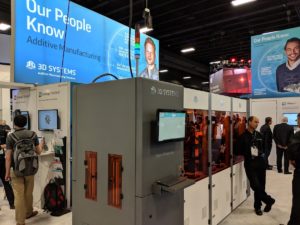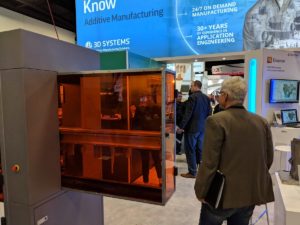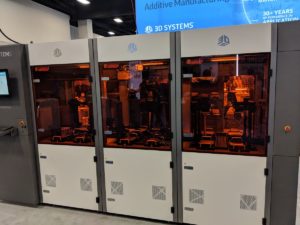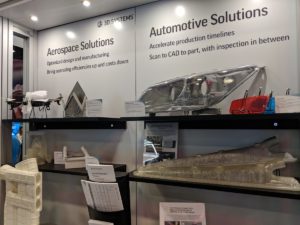From Art to Science: 3D Systems Execs Continue Discussion on Taking 3D Printing from Prototype to Production
 When 3D printing first emerged, it was squarely targeted at rapid prototyping; 3D Systems understands this origin perhaps better than most, as the original patent for stereolithography (SLA) 3D printing was awarded to company co-founder and CTO Chuck Hull. A lot has happened since the 1980s, and technological and market advances have seen 3D printing advance into production. While not discounting the place of prototyping, 3D Systems has been encouraging focus on additive manufacturing for production, targeting both messaging and product introductions for end-use manufacturing.
When 3D printing first emerged, it was squarely targeted at rapid prototyping; 3D Systems understands this origin perhaps better than most, as the original patent for stereolithography (SLA) 3D printing was awarded to company co-founder and CTO Chuck Hull. A lot has happened since the 1980s, and technological and market advances have seen 3D printing advance into production. While not discounting the place of prototyping, 3D Systems has been encouraging focus on additive manufacturing for production, targeting both messaging and product introductions for end-use manufacturing.
“As we’ve talked about for the last two years, we are now looking to product launches in hardware, materials, and workflow. These three things create opportunity for applications,” 3D Systems President and CEO Vyomesh Joshi (VJ) began as I sat with him and several other company executives to discuss the latest introductions and strategies at the recent RAPID + TCT.
“For example, in dental, we have created an incredible architecture with NextDent. For the development of the FabPro, materials and workflow have been key. It’s the same for Figure 4; we have been taking orders today. We have been telling the market, if you have a use case, let us help. This all is how we pave the way in going from prototyping to production.”
Of the highlighted examples, we have already since heard that the US Air Force will be employing Figure 4 technology to reproduce components for older planes, while dental applications have been a focus for some time, including last year’s NextDent acquisition. The FabPro 1000, 3D Systems’ sub-$5K desktop production 3D printer, was introduced late last year as the company expanded its portfolio to meet a variety of market needs.

3D Systems President and CEO Vyomesh Joshi (VJ), left, and Phil Schultz, Senior Vice President, General Manager, Plastics, On Demand Manufacturing, Entertainment
During that high-profile launch, the company detailed an aggressive approach to maintain its long-standing position of leadership in the market. 3D Systems has been nothing if not consistent on its stance, and at RAPID + TCT that aggressive approach remained in focus. Speaking with VJ; Phil Schultz, Senior Vice President, General Manager, Plastics, On Demand Manufacturing, Entertainment; and Director of Public Relations Nicole York and Vice President of Communications Greg Caldwell, we covered the team’s latest focus on taking 3D printing into production with 3D Systems’ most recent announcements.
“We’ve said that a lot, going from prototyping to production,” Schultz acknowledged with a smile.
“It’s more accurate to say we are adding production to our portfolio; we’re not moving away from prototyping.”
 The conversation then focused on that portfolio and what the latest offerings and advances from 3D Systems allow for its customers.
The conversation then focused on that portfolio and what the latest offerings and advances from 3D Systems allow for its customers.
“The FabPro is a $5,000 industrial system built for small businesses. It has industrial-level repeatability, it’s a machine that can hold up to small business applications, to engineering use, in an entry-level space. From there, we go on up to the Figure 4 family. The FabPro is contact-level DLP, whereas the Figure 4 is non-contact; parts never touch the film, which is why it goes so fast. This offers the ability for industrial-level performance with the replication that is needed. We use the phrase ‘digital mold.’ It’s a crossover with what you would do with injection molding,” Schultz continued.
“This is the beauty of technology, this worfklow. With 3D Sprint software, what the engineer learns transfers up to the next system, so they can transfer seamlessly into production. The part is the part. We offer the ability to transition, which we believe will unlock new opportunities.”
The part may be the part, but getting there is, of course, the challenge of production-level 3D printing. The team at 3D Systems understands, as VJ often points out, that it comes down to material capabilities. Schultz underscored this point as well, and noted that materials are key to the company’s strategic approach. The company has announced more than 30 materials for Figure 4 Production, including durable materials (RGD-BLK 10), high-speed material with up to 100 mm/hr build speed (RGD-GRY 10), rigid material for production (RGD-GRY 15), elastomeric black material for iteration and design verification of flexible parts (ELAST-BLK), and a castable green material for investment casting of jewelry patterns (JCST-GRN).
The full ecosystem of offerings is designed to provide accuracy and repeatability suitable for a variety of environments. Repeatability starts with getting started — and sales are starting soon as these systems make their way onto the market.
“The availability of the FabPro is in late May,” VJ told me. “Figure 4 will be in Q3; we are taking orders now. There’s a long lead time. The technology is there, we need to get the production there.”
Figure 4 Standalone systems will be priced starting under $25,000, while Figure 4 Production systems can be customized and configured for individual customers, with pricing and scale determined accordingly.
Announced for general availability is the ProX SLS 6100, introduced in November and which Schultz noted as hitting a “breakthrough price point” of under $300,000 for a turnkey, production-capable solution. The team, he told me, is especially proud of the thermal control in the machine’s chamber, which halved the standard deviation of density from previous generations, among other updates implemented in this next-generation platform. Betas have been placed for this system, he noted, and shipping begins next month. VJ pointed out as well that eight materials have been announced with the 6100.
With, as always, so many announcements and an ever-more-expansive portfolio, I asked the team how the reception has been.
“I’ll be the first to tell you that we still have a lot of work to do,” VJ told me.
He noted, though, that progress is encouraging. The FabPro has been surprising potential customers with its material capabilities, offering impressive functionality out of an accessibly priced system. 3D Sprint software offers what VJ said is, “in my mind, what designers are looking for” with a turnkey, plug-and-play solution. Schultz noted that response has been strong as well for Figure 4.
“Besides material properties, besides surface finish and ease of use — not just because of 3D Sprint — beta customes say this is the fastest system to get parts off,” he said.
“We’re working on auto support generation, we’re working on refinements. If I want to empower a customer, I have to enable, have to make the whole system smarter — the whole industry does — it needs to go from art to science.”
Figure 4 sees great potential especially in the dental arena, where Schultz calls it a “real game-changer’ and VJ notes that the “overwhelming feedback is that it’s a breakthrough,” as the system can speed up dental lab operations by four times and offers up to 90% cost savings. This, he continued, is an “integration resonating with users.” Alpha customers are responding so well, in fact, that they “want to run this day in and day out because the reliability and productivity are above their expectations,” VJ said. In Q3, 3D Systems will be ramping up their focus on Figure 4 as the systems hit the market.
“We have taken alpha testing customer feedback to make the Figure 4 Production machine. We are integrating this into operations, examining up time, and feedback has been very positive. This is not a prototyping machine, so it has to run 24/7, has to have that up time,” VJ told me. “I have the confidence to say that customers are coming back, with more use cases, more feedback. It is all about the customer implementation. That response has given us the confidence in use cases, in production.”
The 6100 system has also had what Schultz called “rave reviews” as the temperature control capabilities allow for the running of parts “not typically possible without warpage.” VJ said that the SLS system, working with proven materials, achieves parts with 50% density, which is “helping us to really win the customers” with a value proposition allowing for “productivity and a desirable total cost of operations.” The size and cost benefits of the system are, they agreed, opening new opportunities. Material reusability is also “getting good reviews,” Schultz said, as the material handling system has been rethought.
Another strategic approach VJ and Schultz noted is in accessing emerging geographies. Making more technology available to wider swaths of the world will both broaden business and expand global capabilities, enabling the popular notion of democratization in manufacturing. VJ noted an “incredible response” in China and other nations, while Schultz pointed to “whole portions of the world we can access, with robust, reliable offerings.”
Keeping up with 3D Systems’ announcements and expansions is always a whirlwind, and conversations at industry events prove enlightening. The company has been a mainstay in the industry since the earliest days of 3D printing, and maintains a leadership position and dedication to ongoing R&D.
Shortly after our conversation at RAPID + TCT, 3D Systems released its Q1 financial results. In the announcement, VJ noted that he was pleased with the revenue this quarter, up 6% from last year.
“While we still have work to do, we believe our investments in go-to-market, process improvements and better execution worldwide are starting to show returns,” he said.
Discuss 3D Systems, strategic approaches, and other 3D printing topics at 3DPrintBoard.com or share your thoughts in the Facebook comments below.
[All photos: Sarah Goehrke]
Subscribe to Our Email Newsletter
Stay up-to-date on all the latest news from the 3D printing industry and receive information and offers from third party vendors.
You May Also Like
Profiling a Construction 3D Printing Pioneer: US Army Corps of Engineers’ Megan Kreiger
The world of construction 3D printing is still so new that the true experts can probably be counted on two hands. Among them is Megan Kreiger, Portfolio Manager of Additive...
US Army Corps of Engineers Taps Lincoln Electric & Eaton for Largest 3D Printed US Civil Works Part
The Soo Locks sit on the US-Canadian border, enabling maritime travel between Lake Superior and Lake Huron, from which ships can reach the rest of the Great Lakes. Crafts carrying...
Construction 3D Printing CEO Reflects on Being Female in Construction
Natalie Wadley, CEO of ChangeMaker3D, could hear the words of her daughter sitting next to her resounding in her head. “Mum, MUM, you’ve won!” Wadley had just won the prestigious...
1Print to Commercialize 3D Printed Coastal Resilience Solutions
1Print, a company that specializes in deploying additive construction (AC) for infrastructure projects, has entered an agreement with the University of Miami (UM) to accelerate commercialization of the SEAHIVE shoreline...



































